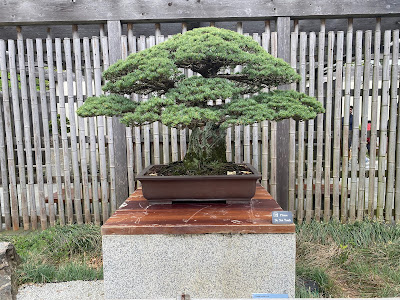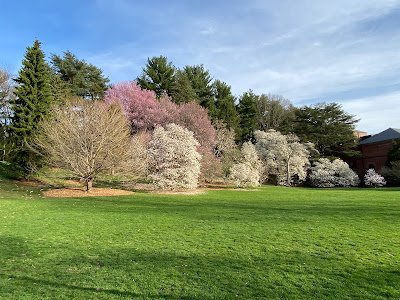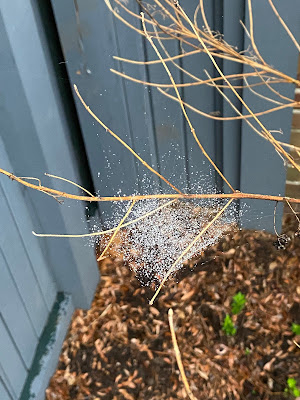April 2023
Sunday April 2 Walking at Fresh Pond in the late afternoon with Susan, we spotted a single red-throated loon; I suspect it will soon be migrating to its breeding grounds in the Arctic. Several ring-necked ducks still around; they'll be gone soon, too. Also in the spring department, a mute swan sitting on a nest on Little Fresh Pond and an eastern phoebe, a recent migrant arrival, at Black's Nook.
Tuesday April 4 Tiny nano-leaves on the willows creating a faint haze of green and spring.
This evening we went to Boxborough, just west of Boston, to look for woodcocks doing their strange courtship display. They usually just snuffle along the ground, in woods or in grassy areas at the edge of a wood, eating worms which they find with their long bills. But in the spring, at dusk, the males display at "singing grounds", starting with almost electric, buzzy "peent" calls, then spiraling upward in flight. As they get high off the ground, the feathers in their wings vibrate, creating a twittering sound. At around 300 feet, they zig-zag downward, chirping, until they (hopefully) land close to a female. They then start the display all over again. Their antics have led to some vivid alternative names: Labrador twister, bog sucker, timberdoodle and night partridge. The first is a little odd, as they don't actually live in Labrador.
Shortly after we arrived, at dusk, we could hear them making their peent calls. And as the light dimmed, I saw one, faintly, snuffling in the grass. But as we waited and waited, and it grew darker and darker, nothing else, no flight displays. Disappointing. On the up side, lots of frog peeping from the nearby vernal pool; you can hear it on the audio in this clip.
Wednesday April 5 A single pair of common mergansers at Jamaica Pond.
Thursday April 6 Two male ruddy ducks, looking ruddy, ready to breed, at last. This is how the Cornell All About Birds website describes them: "Breeding males are almost cartoonishly bold, with a sky-blue bill, shining white cheek patch, and gleaming chestnut body." The ones I saw were snoozing, with their bills tucked into their wings, so I didn't get to see the blue bill.
Also two pairs of buffleheads. Lots of woodpecker drumming. Cardinals going nuts.
And the common mergansers are gone, headed for the Canadian boreal forest to breed. It's been wonderful to see so many of them staying on at the pond this winter.
Friday April 7 A pair of wood ducks on Ward's pond, swimming about near a nesting box on a pole in the water. At the ball field by the Jamaicaway, a hawk was sitting on last year's nest on the light pole; first time I've seen it there this spring. I'll be keeping an eye out for the young.
Allandale Farm, the local farmstand/gardening store, opened this week. Visiting today, everyone had a general air of benevolence - customers basking in spring, surveying the new plants for their gardens, staff gleeful to be back again.
In the evening, letting Maddie into the backyard after our walk, heard a bit of a scramble then spotted a racoon up on my fence, pausing to check us out before heading off down the other side of the fence.
Sunday April 9 Carpets of blue scilla at the Arb today.
Monday April 10 For the week or so, there has been great excitement over reports of up to 70 North Atlantic right whales, 20% of the entire remaining population, in Cape Cod Bay. They are one of the most endangered large whale species (early commercial whalers gave them their name - they were the "right" whales to hunt because they floated when killed). They're huge baleen feeders, up to 52 feet in length and up to 100 tons in weight (at birth,
calves are around 17 feet - yikes!). About 20 years ago, I was on a PhD committee of a student who was studying ship collisions with right whales; one of the things she looked at was the mechanics of lower jaw fractures (my recollection is that their lower jaws can be something like 14 feet long). Studies like hers inform restrictions on ship speeds in areas with right whales.
At the beginning of the month, they were even going into Cape Cod canal, forcing its closure. And for a couple of days, many were seen from the beaches at Herring Cove and Race Point in Provincetown. So we had to go, to see if we could see them, too.
One of the park rangers at the Salt Pond visitor center in Eastham said people were still seeing the whales from the Provincelands visitor center observation tower near Race Point. So off we went. And, to our great delight, we saw them! Spouting. Backs and fins out of the water. Tails upright as they dove. Not just one or two, but maybe a dozen or so. Exciting! More the next day, too. Very cool!
And birds: Northern gannets plunge-diving; red-breasted mergansers, too many to count; common eiders; buffleheads; long-tailed ducks, migrating through on their way to the Arctic. Brant geese in the water just off Susan's condo.
On the drive to Provincetown, at the Eastham police station, we spotted a large stick nest up on the communications tower. Pulling off into the parking lot, we saw an osprey sitting on the nest and then a second fly in with a fish in its talons.
And at the Truro police station, we saw another nest on the communications tower, and another osprey fly in with a fish in its talons. So great to see them thriving. In the 1950s and 1960s, spraying of DDT, as an insecticide, caused the shells of osprey's eggs to be thinner than normal. They were so fragile that they frequently broke, causing osprey numbers to dwindle so dramatically that they were listed as an endangered species. Since DDT was banned in 1972, their numbers have recovered.
Wednesday April 12 Our paper on desert sandgrouse feathers is out today and made it onto the MIT homepage; here's the iStock photo they used:
Namaqua sandgrouse live in the desert in southern Africa, eating seeds that they find in the sand and drinking at watering holes. But the young, at nests in the desert, can't fly to get to water. Instead, the adult males wade into a watering hole, fluff up their belly feathers (as in the photo), and fly back to the nest, carrying water held in their feathers. By looking at the microscopic structure of the feathers and seeing how it changes when wetted, we were able to explain how they do it.
The MIT press release generated lots of media interest, including this interview I did with Quirks and Quarks, the CBC science radio show. And here's a little painting one of my former students, Jie Liu, made when she saw the sandgrouse article on the homepage.
Friday April 14 Lovely early morning light on my walk with Maddie at Jamaica Pond.
And later on in the morning, magnificent magnolias in blossom at the Arb. Walking along, spring bursting everywhere: more flowering, more birdsong: Carolina wrens, red-winged blackbirds, palm warblers, woodpeckers drumming. A tree swallow, with its electric blue back and wings and white belly, perched on a nesting box in a meadow.
Monday April 17 Rain yesterday, this morning's fine droplets of mist caught in a spider's web in my garden.
Tuesday April 18 Biking along the Muddy River, saw a pair of green-winged teal and a male wood duck.
Our friend, Maureen, saw this unusual leucistic house sparrow, lacking pigment in its feathers, in Mt. Auburn Cemetery.
 |
| Photo: Maureen Brodoff |
Thursday April 20 Yesterday, driving down to DC, spring unfolding faster and faster the further south we drove. Spring full on in DC: trees fully leafed out, dogwoods, lilacs, peonies blossoming. We're staying with my friend Marisa, who lives by Rock Creek Park and Connecticut Ave., not far from the zoo. This morning, early, I heard a monkey howling.
Early in the pandemic, Susan had been following the National Zoo's panda cub, Little Miracle (Chinese name Xiao Qi Ji), closely, so we went to check in on him. He just left his mother at the end of February and is now in his own enclosure.
 |
| Photo: Susan Brand |
And we had to see the new bird house, with mostly birds one might see in New England. I was very tickled to see that they had several ruddy ducks in breeding plumage, with their robin's egg blue bills.
Friday April 21 Hot today, forecast to be 87F (31C), so we did indoor activities. At the National Archives Museum, saw the Constitution, the Declaration of Independence and the Bill of Rights. Got a little bit of nature at the National Gallery of Art: the Chinese fringe trees on the rooftop garden were at the peak of their blossom, looking like a work of art, too.
I was also taken with the Calder rat, with its wonderful wire whiskers
and his songbird.
Saturday April 22 Marisa joined us for a trip to Kenilworth Aquatic Gardens, at the southern end of DC, near the Anacostia River. Several rectangular ponds created to cultivate aquatic plants, then a boardwalk out to the river, where we saw an osprey hunting for fish, circling, then hovering over a possible meal. It's Earth Day, lots of volunteers in hip waders digging out invasive species from the ponds.
After Kenilworth, we headed to the National Arboretum with its spectacular display of azeleas, bordering pathways along a wooded hillside. Lots of people out enjoying the flowers and the day.
We loved the Arboretum's extensive bonsai collection, cultivated in the Japanese, Chinese and North American traditions, with the bonsai of each region held in separate pavilions. All in an atmosphere of quiet, peaceful contemplation.
 |
| Japanese white pine, started in 1625. |
And a few bonsai azaleas, some blossoming.
Tuesday April 25 Last night, we stayed with our friends, Liz and David, in Guilford, CT. This morning, before heading home, we stopped at the bald eagle nest they showed us on our last visit on February 22. This time, an eaglet(!), still at the fluffy, grey stage, on the nest, along with an adult. We just got glimpses of the eaglet as it raised its head up before dropping down into the nest again. As we watched, the other adult flew in, wings spread, talons holding a fish. Very cool!
Thursday, April 27 Riding my bike along the Emerald Necklace this morning, I stopped to check on the red-tailed hawk nest on the lights at the ball field. Couldn't see anything at first, but then as I watched, one of the hawks flew in, landing on the nest. After a couple of minutes, it flew over to the next set of lights and stood there for a bit.
Friday April 28 Trilliums out at the Arboretum.
Saturday April 29 Ned Friedman, the Director of the Arboretum, enthused about spruce cones in his latest email:
"Botany rule #17: all conifer cones, for the last 300 million years (give or take) are unisexual. Each cone either produces pollen (male function through sperm) or seeds (female function through eggs). For well over a century, plant morphologists have known of conifer tree weirdos that can produce strange looking bisexual or hermaphrodite cones in addition to normal pollen-producing or seed-producing cones. While no one knows why this happens, it is rare and definitely something to see when the opportunity arises.
This week, at the Arboretum, one of oour Lijiang spruces, Picea Likiangensis (243-92*C) has broken bud, revealing hundreds of hermaphrodite cones right at eye level - and easily found at the south end of Conifer Path near Walter Street Gate. Of course, the brilliant reds of young spruce cones are one of my favority obsessions each spring at the Arnold. But, to top it off with this rare phenomenon is icing on the cake.
A very few are entirely normal pollen-producing cones (top image) or seed-producing cones (middle image). But the vast majority are bisexual (bottom image), with pollen-producing structures at the base and seed-producing structures at the top. Interestingly, the ratio of male to female structures within a cone varies from mostly male to mostly female. And again, who knows why? Just enjoy."
And this is what we saw:
 |
| Pollen producing cones (male) |
 |
| Seed producing cones (female) |
 |
| Bisexual cones (male and female) |
Nearby, a ginko, with little leaves just coming out.
Beth and Dale, and Shirley and Amelia, came around for dinner tonight and brought their dogs, Marsha and Sophie, who were fascinated by our neighbors' cat in their window.
 |
| Marsha (left), Sophie (right), Patches the cat. Photo: Beth Beighlie |
Sunday April 30 To finish up the month, we went to the Art in Bloom show at the Museum of Fine Arts. The museum assigns an artworks to local garden clubs which then make floral arrangements inspired by the pieces.
I've always loved Gustave Caillebotte's Fruit Displayed at a Stand; I was especially tickled by the flowers mirroring the colors and by the sponsorship by Roche Bros. supermarket.
And I thought that Chihuly's Lime Green Icicle was perfectly represented by this simple bamboo arrangement:
Finally, not part of the Art in Bloom show, I had to take a photo of the wall of paintings of Niagara Falls, my home town.






























Comments
Post a Comment